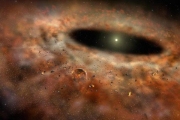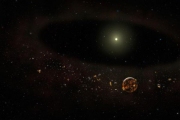|
Viewings: 4712
TYC 8241 2652 1, the star of spectral class Q2, distant from Earth at 450 light-years, made a real circus: the surrounding gas-dust disk was glowing in the infrared range all the time observations, and then suddenly disappeared.Starting from 2009, the astronomers had hoped that it has covered some object, but now it's time to admit that this is not an error observations, and about the disappearance of the disk in the unthinkable by astronomical standards ultra short time. The study of this problem was attended by scientists from a number of American universities, including the University of Georgia, University of California San Diego, University of California Los Angeles and the Polytechnic University of California, as well as representatives of the Australian national University. Conventional wisdom suggests that gas-dust disk around the star disappears at least hundreds of thousands of years, sometimes it requires millions of years. No known mechanism to simultaneously "missing" science is not known, and indeed the possibility of such event had not previously considered. This picture around orange dwarf TYC 8241 2652 1 saw a couple of years ago. (Here and below Fig. Gemini Observatory, AURA, Lynette Cook.) Since 1983, the young star TYC 8241 2652 1, which is about 10 million years, was observed in the infrared range: its disc shone at a wavelength of 10 microns. The temperature was considered equal to 180 C, and began the drive on such a distance from their sun, which is approximately equal to the distance from mercury to the Ground. In 2008 telescopes registered object, and in 2009-m infrared radiation from the disk has fallen by two-thirds. In 2010, the drive has disappeared almost completely, which was confirmed by a number of telescopes. "It's the same as if we are two years did not look at Saturn, and then you would see that he had no rings," says Ben Zuckerman from the University of California in Los Angeles, one of the authors of the study. According to existing ideas and adhesion of particles of gas and dust in protoplanetary disks occurs slowly, at first due to electrostatic forces, then by gravity. For Solar system was assumed that: over 100 million years after the beginning of thermonuclear reactions in the sun all the planets were formed. "If what we saw, refers to a model, then the formation of planets is much faster and more efficiently," said the astronomer. And if so, the planets around TYC 8241 2652 1 formed in three years - almost ten-billionth part of the overall period of her life. However, assumptions about the possibility of fast formation of the planets of protoplanetary disks already been done, in particular by developers of mathematical models of planetearth.su, although they were cautiously welcomed the bulk of the astronomers. And so the situation is, presumably, looks now: the disk is almost gone, the planet was formed. Is the process culminated in a couple of years?! The second possible explanation is the displacement of particles of a disk into the distance from a star under light pressure. Then the temperature of the gas would be to fall sharply, and he really would disappear from view telescopes, as happened in 2009-2010. It is not clear why it happened so sharply: luminosity stars in recent years has not increased, so hurry disk migration seems inexplicable. Third theory postulates that the gas-dust disks is not necessarily a protoplanetary education. Dust in large numbers generated by the collision of planets, forming disk of small particles products cataclysms. If so, the existing assumptions about the number of stars with planetary systems will have to reconsider. Now it is believed that one third of all the suns of Galaxies can have on the planet. However, if gas-dust disks are formed only at collision of planets and live a very short time, being able in just two to three years to disappear completely, we should not see these disks around an absolute majority of stars with planetary systems. So, young stars with planets much more than anticipated? According to the study, astronomers expect to start searching stars from the gas-dust disk seen in the infrared region since 1983, who then suddenly started to decline sharply luminosity of the disk. The aim of research is to understand how often gas-dust disk may be lost for a couple of years. Based on the materials of the University of Georgia.  Com-Eva: 0 Com-Eva: 0
You are reading news Газопылевой диск вокруг звезды исчез на глазах у астрономов
if You liked the article Газопылевой диск вокруг звезды исчез на глазах у астрономов,
prokomentiruet her.
|
The world of the unknown - Onua.org
Onua.org - this site created to familiarize the user with the world of the unknown, news of technology, space discoveries and mysteries of the Earth UFO, Video , Photo, the Witnesses, the mysteries of history and ancient civilizations.
Menu
- Anomalies
- Hypothesis
- The Mysteries Of History
- Unknown
- News
- Opening
- Top secret
- Prophets
- Ancient civilizations
- Egypt
- Rome
- Greece
- Anunaki
- Nazca
- Maya
- Cosmos
- Technology
- Flora and Fauna
- Atlantis
- Bermuda triangle
- Aliens and UFOs
- Cloning
- Loch Ness
- Mysticism and Magic
- Time machine
- Parallel world
- The Tunguska meteorite
- Third Reich
- Teleportation
- Snow man
- 2012
- Nibiru
- Solar system
- The sun
- Earth
- Mars
- The rest of the planet
- Photo
- Video
- A little about everything
- Украинские аномалии
- 2013-2014 YEAR
- Questions and answers
- 100 great
Interesting
Recent VIDEOS
News calendar
Join
Popular Onua.org
Photo

The biggest fish in the world - not blue whale as one might think, because the whale belongs to a ma

Before it was invented fridge, its functions were performed in the ice, which was considered a preci
Предлагаем восстановить, заказать, купить диплом Вуза в любом городе России. Только настоящий бланк ГОЗНАК с гарантией.














